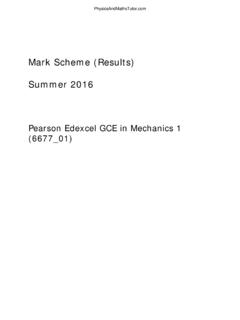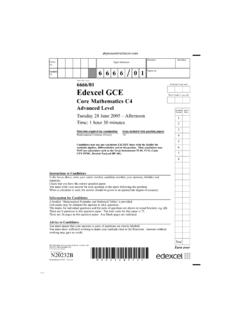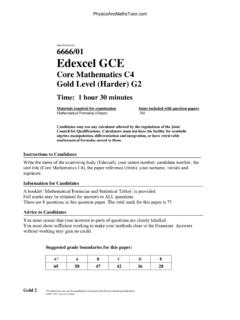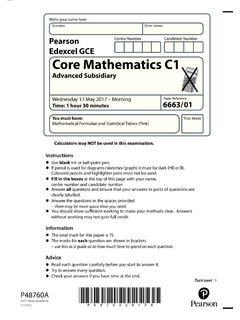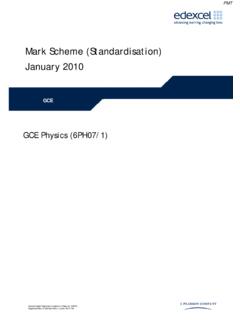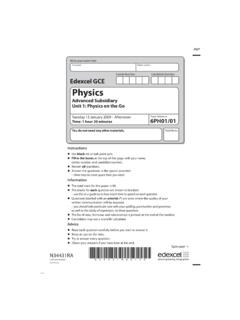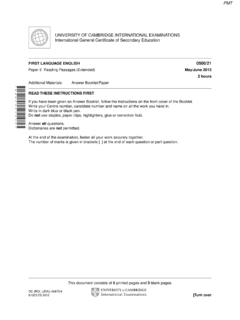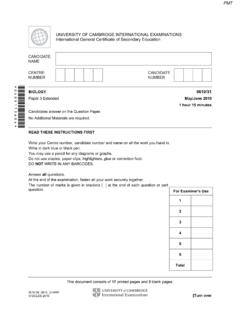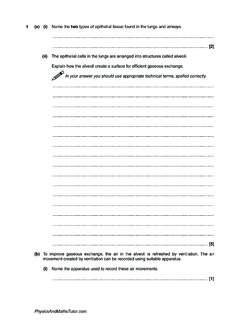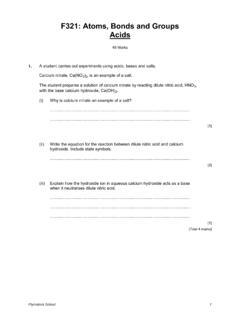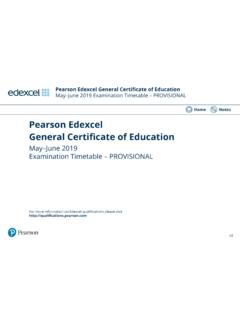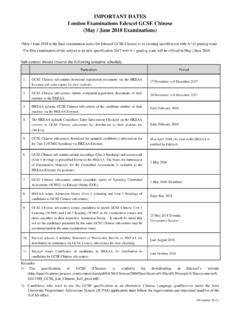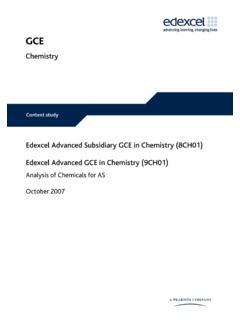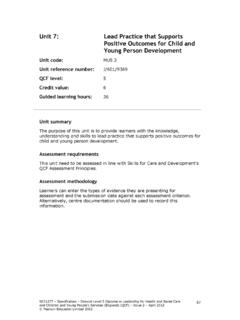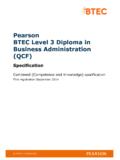Transcription of Mark Scheme (Results) Summer 2016
1 Mark Scheme ( results ) Summer 2016 pearson edexcel GCE in Biology (6BI04) Paper 01 The Natural Environment and Species Survival edexcel and BTEC Qualifications edexcel and BTEC qualifications are awarded by pearson , the UK s largest awarding body. We provide a wide range of qualifications including academic, vocational, occupational and specific programmes for employers. For further information visit our qualifications websites at or Alternatively, you can get in touch with us using the details on our contact us page at pearson : helping people progress, everywhere pearson aspires to be the world s leading learning company. Our aim is to help everyone progress in their lives through education. We believe in every kind of learning, for all kinds of people, wherever they are in the world. We ve been involved in education for over 150 years, and by working across 70 countries, in 100 languages, we have built an international reputation for our commitment to high standards and raising achievement through innovation in education.
2 Find out more about how we can help you and your students at: Summer 2016 Publications Code 46620_MS* All the material in this publication is copyright pearson Education Ltd 2016 General Marking Guidance All candidates must receive the same treatment. Examiners must mark the first candidate in exactly the same way as they mark the last. Mark schemes should be applied positively. Candidates must be rewarded for what they have shown they can do rather than penalised for omissions. Examiners should mark according to the mark Scheme not according to their perception of where the grade boundaries may lie. There is no ceiling on achievement. All marks on the mark Scheme should be used appropriately. All the marks on the mark Scheme are designed to be awarded. Examiners should always award full marks if deserved, if the answer matches the mark Scheme . Examiners should also be prepared to award zero marks if the candidate s response is not worthy of credit according to the mark Scheme .
3 Where some judgement is required, mark schemes will provide the principles by which marks will be awarded and exemplification may be limited. When examiners are in doubt regarding the application of the mark Scheme to a candidate s response, the team leader must be consulted. Crossed out work should be marked UNLESS the candidate has replaced it with an alternative response. Question Number Answer Additional Guidance Mark 1(a) 1. {antigen / bacteria / virus / pathogen} {binds / eq} to B cell ; 2. {antigen / bacteria / virus / pathogen} {binds / eq} to MHC (antigen) ; 3. T helper {lymphocytes / cells} {bind / eq} (to B cell) ; 4. reference to cytokines (from T helper cells) ; 1 ACCEPT B cell is an antigen-presenting cell 3 ACCEPT CD4 cells (3) Question Number Answer Mark 1(b)(i) mitosis ; (1) Question Number Answer Additional Guidance Mark 1(b)(ii) 1. idea of sample of B cells from lymph nodes ; 2. reference to named stain (acetic) orcein ; 3.
4 Credit correct details of method for B cells heating / add { HCl / acid } ; 4. idea of looking for mitotic features ; 1 ACCEPT from blood 2 ACCEPT acetocarmine, Feulgen s, Schiff s, toluidine blue 3 ACCEPT squashing of lymph node 4 ACCEPT stages of mitosis (3) Question Number Answer Mark 1(c)(i) C mitochondrion ; (1) Question Number Answer Mark 1(c)(ii) C nucleus ; (1) Question Number Answer Additional Guidance Mark 1(c)(iii) endoplasmic reticulum / ER ; IGNORE smooth , rough ACCEPT RER / SER / ribosome (1) Question Number Answer Additional Guidance Mark 1(c)(iv) IF RER / SER HAS BEEN GIVEN AS ANSWER IN (iii): 1. {protein synthesis / translation / eq} occurs ; 2. on the ribosomes ; 3. idea that {polypeptide / protein} {moves into / transported into} the ER ; 4. to the Golgi apparatus / through the cytoplasm / eq ; IF GOLGI HAS BEEN GIVEN AS ANSWER IN (iii): 5. it modifies the protein / eq ; 6. credit example of modification addition of carbohydrate group ; IF CYTOPLASM HAS BEEN GIVEN AS ANSWER IN (iii): apply either the RER OR Golgi Mps 1 ACCEPT description of translation 4 ACCEPT idea of folding into {secondary / tertiary} structure 7.
5 Idea that antibody moved into vesicles ; 8. exocytosis / eq ; IF RIBOSOME HAS BEEN GIVEN AS ANSWER IN (iii): 9. {protein synthesis / translation / eq} occurs ; 10. ribosome holds mRNA / eq ; holds two tRNA / eqs ; that peptide bonds can form between (adjacent) amino acids ; (3) Question Number Answer Mark 2(a) (3) Question Number Answer Additional Guidance Mark 2(b)(i) 1. idea of little difference between the groups (at each incubation time) ; 2. idea of {large / eq} error bars ; 3. idea of {overlapping / eq} error bars ; 2 and 3 ACCEPT range bars (2) Cytoplasm Question Number Answer Additional Guidance Mark 2(b)(ii) 1. idea that membrane {receptors / proteins / glycosidic groups / eq} interacts with bacteria ; 2. idea of {pseudopodia formed around / macrophage surrounds} the bacteria ; 3. idea that membranes (of pseudopodia) {fuse / pinch off / eq} ; 4. to form a vacuole (that contains the bacteria) / eq ; 5.
6 Idea that {change in shape / fusion /movement / eq} of membrane is due to fluidity of membrane ; 6. caused by the {movement of phospholipids / presence of cholesterol / eq } ; 1 ACCEPT antibodies bind to both bacteria and macrophage / opsonisation 2 IGNORE engulf 4 ACCEPT vesicle, phagosome (4) Question Number Answer Additional Guidance Mark 2(c)(i) 1. bacteriostatic antibiotics stop the bacteria from dividing / eq ; 2. bactericidal antibiotics {kill / eq} the bacteria ; IGNORE description of mechanism 1 ACCEPT growing, replicating (2) Question Number Answer Additional Guidance Mark 2(c)(ii) 1. idea that viruses are non-living ; ACCEPT viruses do not have the target sites for antibiotics (1) Question Number Answer Additional Guidance Mark 3(a) 1. (rate at which) energy {incorporated / eq} into {biomass / organic matter } ; 2. by { plants / producers} ; 1 NOT energy produced, converted, turned into ACCEPT organic material, organic molecules 2 ACCEPT by photosynthesis (2) Question Number Answer Additional Guidance Mark 3(b) 1.
7 GPP {depends / eq} on photosynthesis ; 2. higher the temperature the higher the GPP / eq ; 3. enzymes in (photosynthesis / chemical reaction ) {can work faster / more kinetic energy / eq } ; 4. higher the {precipitation / eq} the higher the GPP / eq ; 5. idea that water is needed for the light-dependent reaction ; 6. role of water in transport of { mineral ions / named mineral ion / amino acids / sucrose / eq } ; 1 needs to be a clear statement 2 ACCEPT converse 3 ACCEPT increased enzyme activity 4 ACCEPT converse 5 ACCEPT photolysis, H+ donor, replacing electrons (5) Question Number Answer Additional Guidance Mark 3(c) 1. credit two values that lie in the range: greater than 0 to 11000 ; 2. appropriate justification based on temperature ; 3. appropriate justification based on precipitation ; 1NB (actual value is 126-3100) ACCEPT below 850 (3) Question Number Answer Additional Guidance Mark 3(d) 1.
8 (trophic level 2) 2300 - 1500 / 800 (kJ) ; 2. (trophic level 3) 760 - 690 / 70 (kJ) ; 3. ((70 800) x 100) = / (%) Correct answer gains three marks 3 ALLOW ecf for two values used (3) Question Number Answer Additional Guidance Mark 4(a) 1. idea that enzyme activity decreases ; 2. credit calculated reduction , , ; 3. idea that an increase in temperature results in increase in kinetic energy ; 4. causing changes in bonds (in the enzyme) / eq ; 5. idea that enzyme is denaturing (above 40 C) ; 6. idea that carbon fixation is reduced ; 5 ACCEPT fewer enzyme-substrate complexes NOT starts to denature (5) Question Number Answer Additional Guidance Mark 4(b) {RuBP / ribulose bisphosphate} AND {carbon dioxide / CO2} ; ACCEPT Rubp / ribulose biphosphate NOT CO / CO2 (1) Question Number Answer Mark 4(c)(i) D valid ; (1) Question Number Answer Mark 4(c)(ii) C measuring the activity at 1oC intervals between 35oC and 45oC ; (1) Question Number Answer Additional Guidance Mark 5(a) 1.
9 Idea that cellulose is a {polymer / polysaccharide} of glucose ; 2. reference to 1-4 glycosidic {bonds / eq} ; 3. idea that every other glucose is inverted ; 4. idea of cellulose molecules arranged {parallel /as microfibrils} ; by hydrogen bonds / eq ; 1 ACCEPT made of glucose monomers 3 ACCEPT 180 angle between each glucose (4) Question Number Answer Additional Guidance Mark 5(b) 1. idea of {lack of / very slow} decomposition ; 2. due to lack of {microorganisms / bacteria / fungi / named decomposer} (involved in decomposition) / eq ; 3. as a result there are fewer enzymes / eq ; 4. low pH {reduces enzyme activity / kills microorganisms /eq} ; 5. low oxygen affects respiration (of microorganisms) / eq ; 6. idea that bacteria cannot produce enzymes to breakdown sporopollenin ; 1 ACCEPT breakdown, decay 2 ACCEPT cannot survive 4 ACCEPT acidic (4) Question Number Answer Additional Guidance Mark 5(c) 1.
10 Reference to double fertilisation ; 2. idea that one (haploid) male {gamete / nucleus } fuses with (haploid) {egg cell / egg nucleus / female gamete / female nucleus} ; 3. to produce a {diploid / 2n} {zygote / embryo} ; 4. idea that one (haploid) male {gamete / nucleus} fuses with { polar nuclei / diploid endosperm nucleus / fusion nucleus} ; 5. to produce a {triploid / 3n} endosperm (nucleus) ; 2 ACCEPT sperm nucleus NOT generative nucleus IGNORE ovum / egg unqualified 4 NOT generative nucleus / polar bodies (4) Question Number Answer Additional Guidance Mark 6(a) 1. (overall) increase in pollen count (as the layers get deeper) ; 2. by 28 (au) ; 3. idea that increase is {greater between and 13 m / smaller between 13 and m} ; 4. {22 compared to 6 / 18 compared to 10} ; 5. idea that fluctuations are {greater between and 13 m / smaller between 13 and m} ; ACCEPT as time of eruption 1 ACCEPT converse 3 ACCEPT increase is {greater after the eruption / smaller before the eruption} ACCEPT converse 5 ACCEPT fluctuations are {greater after the eruption / smaller before the eruption} (3) Question Number Answer Additional Guidance Mark 6(b) idea of layers being { destroyed / mixed together / eq } ; ACCEPT area destroyed / layers are indistinct / not clear / no peat / rocks present (1) Question Number Answer Additional Guidance Mark 6(c) 1.
